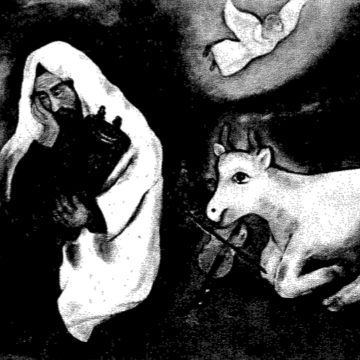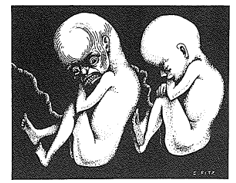When the Extraordinary Synod of the Roman Catholic Church ended (December 1985), thousands of words were written about the event by religious journalists of every variety. More interesting, however, from a rhetorical point of view, was the pre-Synod journalism; it provides an excellent illustration of the not-uncommon attempt of the press to formulate the agenda...
Category: Typefaces
Temporizing on the Thames
It is one of the chief distinguishing features of the philistine that he thinks himself, above all things, “openminded.” While the converse of this proposition is untrue, modern culture having witnessed an explosion in the doctrinaire varieties of philistinism, it is nevertheless a fact that the trueblue, classic philistine, of the kind described by the...
The Man of Mode
“Man at his best” is both the slogan and promise of Esquire magazine. “Best,” in this context, turns out to mean all that money can buy in the way of automobiles, wristwatches, adoring women, and clothes. Fernando Lamas’ paradoxical aphorism (taken seriously by a dull-witted comic who parlayed it into a career) sums it up:...
Rights of Clergy
Any sensible kid in America wants to be a newsman when he grows up or, better still, when he doesn’t. Politicians may have the power to make laws and budgets, but it’s the journalists who make the politicians. Besides, even Presidents have to obey the laws. Journalists, on the other hand, are exempt—or so they...
Psychology Today, Psychology Tomorrow, Psychology Forever
Psyche haunted the Romantic poets and their successors. Coleridge celebrated “the butterfly the ancient Grecians made the soul’s fair emblem and its only name.” Coleridge was a Christian. But the pagan Keats, in his search for a private “system of Salvation,” said his prayers to Psyche, “latest-born and loveliest vision far / Of all Olympus’...
Muffled Voices
“The Noise of the City Cannot Be Heard” was the title of a very popular song in the Soviet Union just after World War II. According to Aleksandr Solzhenitsyn, the song was so much in demand that “no singer, even the most mediocre, could perform it without receiving enthusiastic applause.” The Soviet Chief Administration of...
A Woman’s Dreams
“Most women have no Characters at all,” wrote Alexander Pope: “Good as well as ill, / Woman’s at best a Contradiction still.” The contradiction of womanhood will perhaps never be fully solved, but it has generally been considered manageable within marriage and family. Outside of the home, women are . . . well, we’ve made...
Black and White—and Red All Over
Don’t look for it at the corner news stand or in the promotionals from Publisher’s Clearing House. Except for professional Soviet watchers, few Americans even know of the existence of Culture and Life, an “illustrated monthly magazine of the Union of Soviet Societies for Friendship and Cultural Relations with Foreign Countries,” published in English, Russian,...
The Celebration of Chagall
Whimsy—clumsy or fantastic—fills the minds of those viewing the art of Marc Chagall. Two hundred oil paintings, gouaches, etchings, stained glass, and theater designs, chosen for their quality and their significance in the artist’s career, drawn from public and private collections throughout the world (including generous loans from the artist’s family), were on display at...
Writing Without Letters
Whatever happened to the old middle-to-highbrow American culture? Once upon a time, there was a fair-sized literate class that kept up on fiction and verse by reading the great organs of literary opinion. These days there is a great gulf between serious literature and general-interest journalism. “Literary” magazines—Kenyon Review, Daedelus, or Sewanee Review, for instance—now...
Paparazzi
Andy Warhol used to say that the day would come when every American would have his five minutes on the Tonight Show. Warhol, although he squandered his talents on films and interviews with nonentities, was still a prophet of sorts: he must have realized that nothing drives a decadent society so much as the hunger...
“A Scientific Faith’s Absurd”
Science, that is, natural and physical science, is supposed to be pure. Those who do science keep their work free from any taint of political belief or social prejudice. The scientific method is itself value-free, beyond good and evil. That, at least, was the theory. In practice, however, scientists are not always so pure. They...
Thunder on the Right
National Reviewhas been the flagship of the conservative movement for almost 30 years. From the very beginning, its editors set the agenda for American conservatism. NR’s peculiar mixture of capitalist anticommunism with the concerns of traditional Catholicism defined the movement. Even before being cursed with the name “fusionism,” it was a potent combination. Where else...
Typefaces – Pulpits and the Press
“The grand Pulpit is now the Press,” Thomas Carlyle argued a century and a half ago, adding that “the true Church of England, at this moment, lies in the Editors of its Newspapers. These preach to the people daily, weekly; admonishing kings themselves; advising peace or war, with an authority which only the first Reformers,...


